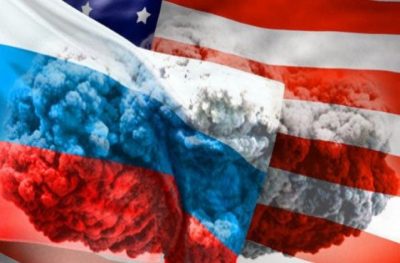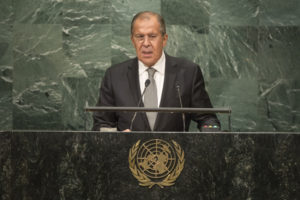Endangering a Landmark Nuclear Treaty with Russia. Jeopardizing Global Security

On Aug. 3, President Trump told millions of Twitter followers to “thank Congress” for the fact that “our relationship with Russia is at an all-time & very dangerous low.” The immediate impetus for his remark was congressional passage of new economic sanctions against Russia, but Trump might just as well have pointed to moves by the body to jeopardize a landmark arms control treaty negotiated in 1987 by President Reagan and Soviet leader Mikhail Gorbachev.
The Intermediate-Range Nuclear Forces (INF) Treaty was remarkable for prohibiting an entire class of existing weapons, with ranges between 500 and 5,500 kilometers. Ratified by the Senate in 1988, following one of the darkest periods of the Cold War, it led to the destruction of 2,700 missiles, both nuclear and conventional, over a period of about three years.
The treaty also opened the door to on-site inspections and other verification measures that made possible the first Strategic Arms Reduction Treaty in 1991, under President George H.W. Bush. Greg Thielmann, a former top State Department intelligence official who advised on the INF treaty negotiations, has called its success “unprecedented” and “one of the world’s most dramatic achievements in curbing the nuclear arms race.”

President Reagan meeting with Soviet General Secretary Gorbachev at the Soviet Mission during the Geneva Summit in Switzerland, Nov.20, 1985. (Photo from Reagan presidential library)
Putting those great accomplishments at risk, the proposed new National Defense Authorization Act, which passed the House in July, authorizes the development of a new land-based missile banned by the INF treaty. A companion Senate bill, which will be considered after the August recess, would fund initial Pentagon development of a similarly prohibited missile.
In each case, the real target of the new missiles proposed by congressional hawks like Republican Sen. Tom Cotton of Arkansas isn’t any particular Russian military capability, but the spirit of cooperation and shared interests that made arms control possible in the years from Nixon to Obama.
Objections to Risk
“The INF Treaty is fundamental to European security,” declared a team of distinguished U.S., German, and Russian nuclear arms experts in April. “If the treaty unravels, it will open the door to an arms race in ground-launched intermediate-range missiles, which will diminish security in both Europe and Asia . . . and undermine the entire regime of nuclear arms control between the United States and Russia.”
The missile-rattling by members of Congress is rooted in Washington’s concern that Russia recently began to deploy an upgraded version of an existing ground-launched cruise missile, dubbed the SSC-8, with a prohibited range beyond 500 kilometers. Russia denies any violation of the treaty, but the U.S. responding to a possible violation by blowing up the entire treaty would be an act of strategic folly.
Tom Collina, an arms control expert with the Ploughshares Fund, told me that he and other independent analysts can’t assess the evidence because it’s so highly classified. But he was impressed by the fact that key members of the Obama administration vouched for it:
“These were people I know supported arms control with Russia, and finding this [breach] was very inconvenient. The last thing they wanted was to have to tell the U.S. Senate that Russia is cheating.”
Gen. James Mattis told the Senate Armed Services Committee during its consideration of his nomination to President Trump’s Secretary of Defense,
“If Russia is permitted to violate the treaty with impunity, such actions could erode the foundations of all current and future arms control agreements and initiatives.”
But the U.S. response doesn’t have to be hasty or extreme. U.S. defense planners aren’t losing any sleep over the limited Russian deployment of its questionable missiles.
“Given the location of the specific missile and the deployment, they don’t gain any advantage in Europe,” said Air Force Gen. Paul Selva, the vice chairman of the Joint Chiefs of Staff, in Senate hearings last month.
Evidence and Inspections
A reasonable approach advocated by many experts is to start by confronting the Russians with more specific evidence of their alleged violation. At a press briefing in June, Russian Foreign Minister Sergey Lavrov said his government was ready for an “honest but specific dialogue” and had “no intention to break the treaty.”

Sergey V. Lavrov, Russia’s Minister for Foreign Affairs, addresses the United Nations General Assembly on Sept. 23, 2016. (UN Photo)
The Russians may be using their cruise missile deployment as leverage to force discussion of their own complaint that NATO’s missile-interceptor systems in Eastern Europe have potential offensive uses. Russian military experts claim the launchers used in those systems can house intermediate-range cruise missiles prohibited by the INF treaty.
Russian military leaders have expressed public concerns about the threat of a surprise attack on their command and control centers from such stealthy and precision-targeted missiles. The short flight times of those missiles to Moscow could facilitate the “decapitation” of Russia’s political and military leadership.
Russia’s fears may be misplaced or overblown, but they are fanned by the blatant dishonesty of NATO’s claims that its interceptors are merely designed to defend against ballistic missiles from Iran. Iran has no missiles capable of striking most of Europe. Nor does it have a nuclear weapons program, as confirmed by regular international inspections and the State Department’s own certification.
Moscow’s claims, like Washington’s concerns over Russia’s recent missile deployments, should be amenable to inspection and resolution by panels of technical experts, say nuclear arms experts. The INF treaty created a Special Verification Commission (SVC) to address just such issues.
“U.S. willingness to allow Russian access to deployed [missile interceptor] launchers and Russian willingness to accept on-site monitoring of SSC-8 [cruise missile] launchers at test sites and challenge inspections at suspect deployment sites could lead to a breakthrough in the current compliance stalemate,” writes Thielmann.
Political Obstacles
The technical challenges are real, but Thielmann and other experts suggest the political challenges are even greater. Many congressional hawks evidently don’t want a cooperative resolution of the issue. Although President Trump has sought to work with President Putin, he has also expressed contempt for arms control. (“Let it be an arms race,” Trump told an interviewer in December. “We will outmatch them at every pass and outlast them all.”)
Last but not least, the Pentagon is pushing for a trillion-dollar nuclear “modernization” program and a new generation of smaller nuclear warheads it deems suitable for “warfighting.” Russia, of course, is not standing still, either.
Jon Wolfsthal, the top White House arms control expert under President Obama, reminds us that in today’s poisonous political atmosphere,
“The danger(s) of an accidental or unintended conflict . . . are as high as they have been since the collapse of the Soviet Union.”
Given the immense stakes for all humanity, Trump should invoke the spirit of Ronald Reagan to quell moves by congressional conservatives to derail the INF treaty. Their misguided attempts to grab a temporary lead in the nuclear arms race, instead of pursuing a mutual end to that race altogether, will only put U.S. security more at risk.
Jonathan Marshall is a regular contributor to Consortiumnews.com.

